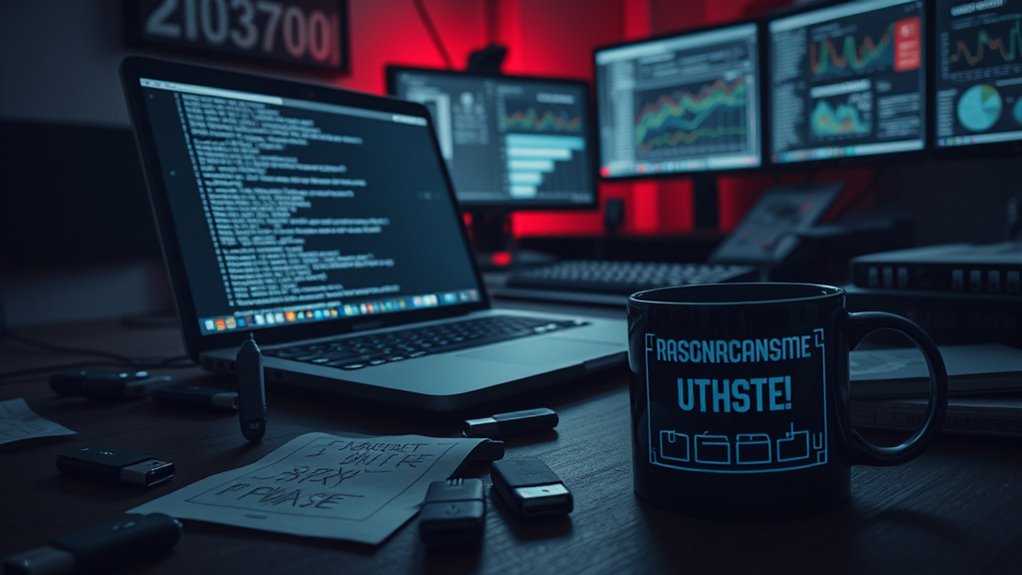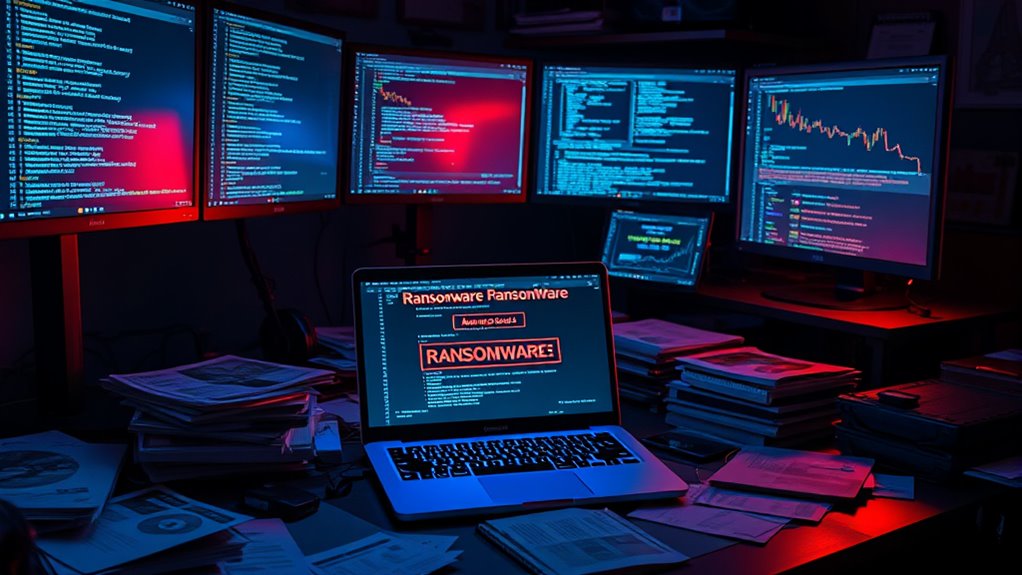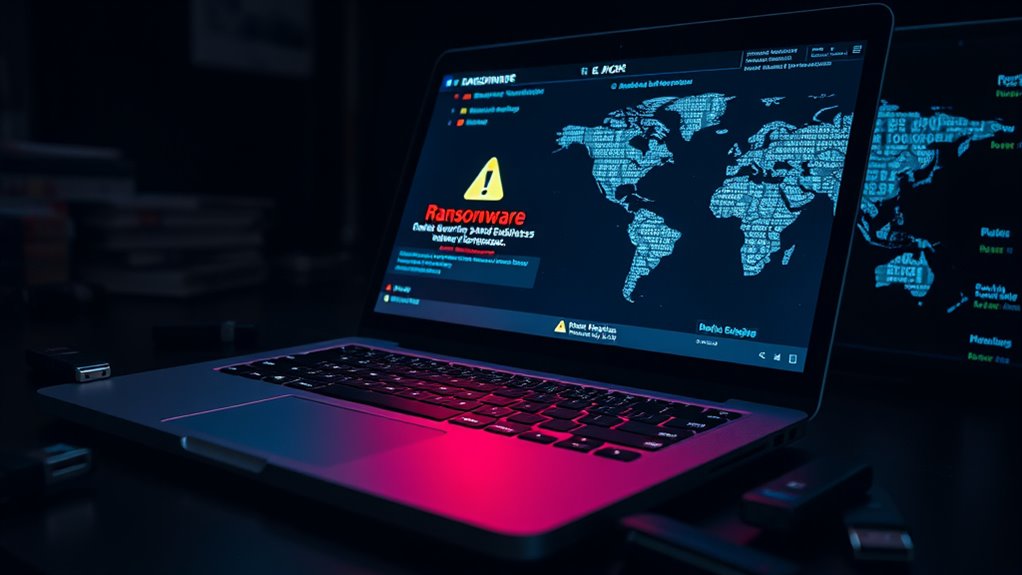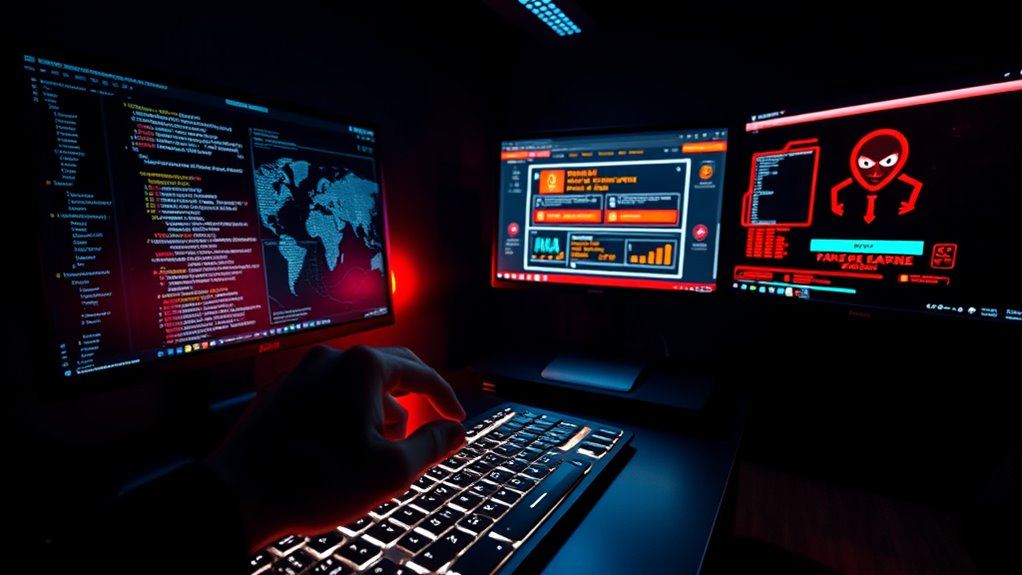Ransomware-as-a-Service transformed cybercrime into a subscription business by offering ready-made malware, infrastructure, and support, making it accessible to even low-skilled criminals. This model relies on developers selling or leasing tools to affiliates, who then launch attacks for profit-sharing. Continuous updates, modular designs, and automation boost attack speed and scale. If you want to understand how this ecosystem keeps evolving and targeting, there’s more to explore.
Key Takeaways
- RaaS platforms offer modular, ready-to-use ransomware tools via subscription, enabling easy access for cybercriminals.
- Continuous updates and support mimic legitimate SaaS, encouraging ongoing subscriptions and loyalty.
- Affiliate networks and profit-sharing models incentivize repeated attacks, creating a recurring revenue cycle.
- Cloud-based infrastructure and automation allow rapid deployment and scaling of ransomware campaigns.
- The ecosystem’s structure, with storefronts and marketplaces, facilitates a subscription-based business model for cybercrime.
Understanding Ransomware-as-a-Service and Its Business Structure

Ransomware-as-a-Service (RaaS) operates like a legitimate software business, but its products are malicious. You, as a hacker or affiliate, can buy or subscribe to ransomware kits that include malware, infrastructure, payment portals, and leak sites. Developers, or operators, create and maintain these tools, offering them through dark web marketplaces with support, reviews, and forums similar to legit SaaS. Your role as an affiliate involves executing intrusions, escalating privileges, and deploying ransomware, while operators handle backend infrastructure. Payment models vary from subscriptions and one-time fees to commissions based on ransom success. RaaS lowers barriers for low-skill actors, enabling rapid entry into cybercrime. The platform’s tools, like data leak sites and management dashboards, streamline attacks and maximize profit opportunities for both operators and affiliates. This business model has significantly expanded the scope and scale of cybercriminal operations worldwide, fueled by the ease of access to cybercrime-as-a-service platforms.
The Rise of RaaS and Its Impact on Cybercrime Proliferation

RaaS platforms have made cyberattacks more accessible by lowering technical barriers and offering subscription-based tools that anyone can rent. This democratization enables low-skilled criminals to launch sophisticated ransomware campaigns, increasing the overall volume of attacks. As a result, the cybercrime landscape is expanding rapidly, driven by continuous innovation and widespread availability of ransomware variants. Furthermore, the rise of accessible tools and techniques in somatic therapy reflects a similar trend of making complex processes more approachable for individuals seeking healing.
Democratization of Attacks
How has the rise of Ransomware-as-a-Service transformed the cybercrime landscape? RaaS platforms have drastically lowered the technical barriers, allowing even those without advanced skills to launch powerful ransomware attacks. They provide ready-to-use tools maintained by specialized developers, turning ransomware into an accessible service. This democratization means more cybercriminals can participate, expanding the attack pool. As a result, the number of ransomware variants and incidents has surged—over 100 identified in 2024, with 73% linked to RaaS. Targeting small and medium businesses has increased, exploiting their weaker defenses. The widespread availability of RaaS has fueled a professionalized, commoditized ransomware ecosystem, making cybercrime more accessible and prolific. This trend has led to a significant increase in the sophistication and diversity of attack methods used by cybercriminals. Law enforcement faces greater challenges as networks become decentralized and diverse, complicating efforts to trace and combat these attacks, thus accelerating attack frequency worldwide.
Business Model Evolution
Since its emergence in 2012 with the Reveton ransomware strain, the business model behind ransomware operations has evolved into a highly sophisticated and organized cybercrime ecosystem. You now see collaboration between developers and affiliates who lease ransomware kits to launch attacks. Specialized roles like initial access brokers help infiltrate systems, making attacks easier to execute. These operations offer complete ransomware kits—malware, instructions, and support—lowering entry barriers for less technical criminals. The ecosystem has become more segmented, with different actors handling malware creation, attack execution, and exploitation. This segmentation has facilitated rapid growth and diversification of attack methods, making defenses more challenging. The rise of professional storefronts on the dark web exemplifies how formalized and commercialized ransomware services have become, resembling legitimate business operations. Crypto payments that hide transactions from law enforcement are a core component, ensuring financial anonymity. Revenue sharing models, with affiliates paying up to 50%, incentivize widespread participation. 24/7 support services for affiliates further streamline attack deployment and troubleshooting. Rapid scaling of attacks due to ready-made platforms underscores the efficiency and profitability of this subscription-like cybercrime model.
Economic Incentives Driving RaaS Operations and Growth

You can see how the soaring ransom payments, averaging over $5 million, motivate cybercriminals to escalate their efforts. With low entry costs and high potential returns, RaaS makes attacking a wide range of targets extremely profitable. This economic allure fuels the rapid growth and sophistication of ransomware operations worldwide. The profitability of ransomware attacks continues to attract new actors and sustain existing cybercriminal networks. Additionally, the easy accessibility of tools and resources within RaaS platforms lowers barriers for new hackers to enter the cybercrime landscape.
Lucrative Ransom Payments
The soaring ransom payments and the substantial financial gains they generate are key drivers behind the rapid growth of Ransomware-as-a-Service (RaaS) operations. In 2024, the average ransom paid skyrocketed to around $2 million—up 500% from 2023—fueling massive revenues for cybercriminals. With blockchain data revealing over $813 million paid in ransom, the financial allure is undeniable. Imagine cybercriminals earning millions with minimal investment, just by deploying malware through a subscription model. Ransomware costs have increased by 574% over the past six years, making RaaS an increasingly attractive and sustainable business model for cybercriminals. The use of malware technology simplifies deployment and allows for rapid scaling of attacks, further boosting profits. Visualize:
- Large organizations paying multi-million-dollar ransoms
- Ransom payments covering recovery costs and profit
- Cybercriminals recruiting affiliates for high-volume attacks
- Low-cost malware development fueling huge payouts
- Threat actors targeting high-value victims for maximum gain
This lucrative cycle sustains and accelerates RaaS’s growth.
Low-Cost, High-Return Attacks
What makes Ransomware-as-a-Service so appealing to cybercriminals is its low entry barrier combined with the potential for massive profits. You don’t need coding skills—just access to turnkey tools that developers handle, including malware updates and infrastructure. This subscription model allows almost anyone to launch attacks, increasing participation. The ability to distribute malware to hundreds or thousands of affiliates exponentially boosts attack volume, with a single strain like LockBit causing hundreds of incidents. Affiliates operate anonymously, minimizing legal risk, while profit-sharing incentives motivate continued attacks. Entry costs are minimal compared to potential ransom payouts, with averages over $300,000. Rapid deployment and automated tools enable quick, widespread attacks, maximizing returns while reducing effort and risk for cybercriminals. Ransomware payments in 2023 exceeded $1 billion, highlighting the profitability of the RaaS model. Additionally, the rise of cybersecurity vulnerabilities during major outages underscores the importance of robust defenses against these threats.
Shifting Targets: From Large Enterprises to Small and Medium-Sized Businesses

While large enterprises once dominated ransomware targets, recent trends reveal a sharp shift toward small and medium-sized businesses (SMBs). You’re now more likely to face attacks if you run a smaller operation. Cybercriminals see SMBs as easier targets with weaker defenses. Imagine:
SMBs are now prime targets due to weaker defenses and rising ransomware attacks.
- 82% of ransomware attacks in 2021 hit SMBs with fewer than 1,000 employees
- 37% of victims had fewer than 100 employees
- SMBs face a 350% higher attack rate than larger firms
- Half to 70% of ransomware incidents target SMBs
- Smaller businesses often lack incident response plans or cyber insurance
- The rise of ransomware product reviews helps hackers identify vulnerable targets more efficiently.
This shift is driven by ransomware-as-a-service platforms, making attacks more accessible and frequent. Your limited resources and outdated security make SMBs prime low-hanging fruit for cybercriminals.
Technological Advancements Making RaaS More Accessible and Effective

Technological advancements have markedly increased the accessibility and effectiveness of Ransomware-as-a-Service (RaaS) platforms, making it easier for even less technically skilled criminals to launch sophisticated attacks. RaaS providers offer pre-built infrastructure, including ready-to-use toolkits, encryption methods, and user-friendly dashboards, eliminating the need for custom malware development. Automation and AI integrations enable automated target selection, phishing, and evasion tactics, reducing manual effort and improving success rates. Subscription and profit-sharing models lower entry barriers, allowing affiliates to join with minimal upfront costs and scale rapidly through rebilling and rebranding. Continuous updates and modular designs keep these platforms sophisticated and adaptable. As a result, cybercriminals with limited technical expertise can now execute large-scale, effective ransomware campaigns with unprecedented ease. The rise of cloud-based hosting and deployment options further facilitates quick setup and global reach for these malicious operations. Additionally, the availability of certifications and endorsements from beauty experts in the skincare industry highlights the importance of verifying credibility, which parallels the need to confirm the authenticity of RaaS providers to avoid scams.
Challenges for Law Enforcement in Combating Ransomware-as-a-Service

Law enforcement faces significant hurdles when trying to dismantle Ransomware-as-a-Service (RaaS) operations because these criminal networks are highly adaptable and resilient. They quickly regroup under new names after disruptions, making it difficult to stop their activities. Their tactics continuously evolve, with groups expanding coercive methods and using multiple channels to contact victims. The ecosystem reshuffles, with affiliates and new actors emerging, often recycling tools and tactics. This constant change complicates tracking and dismantling efforts. Additionally, their international reach requires coordinated global efforts. Imagine:
- Criminal networks reorganizing swiftly after arrests
- Groups shifting to new platforms and tools
- Ecosystems bouncing back despite disruptions
- Emergence of fresh actors using old tactics
- Supply chain attacks impacting law enforcement operations
- The ongoing cycle of emergence, targeting, and reconstitution keeps law enforcement in a relentless pursuit. A deeper understanding of cybercrime ecosystems helps highlight the challenges faced in combating these adaptable threats.
Future Trends and the Ongoing Evolution of RaaS in Cybercrime

Ransomware-as-a-Service (RaaS) continues to evolve rapidly, driven by increasing sophistication and the integration of advanced technology. You’ll see providers offering highly professionalized services, including 24/7 support, frequent updates, and negotiation help. Attack methods now combine social engineering, data theft, and stealthy encryption, often avoiding detection by law enforcement. Modular architectures let affiliates customize payloads, boosting attack adaptability. AI-driven tools, like voice phishing, make social engineering more convincing and easier to execute.
| Future Trends | Impact on Cybercrime |
|---|---|
| Customization & AI | More convincing, targeted attacks |
| Shift in Targets | Focus on SMBs and critical sectors |
| Targeted Campaigns | Higher impact with less exposure |
| Tech Integration | Automation and innovation in attack methods |
Frequently Asked Questions
How Do Raas Platforms Ensure Affiliate Accountability and Trust?
You might wonder how RaaS platforms keep affiliates accountable and trustworthy. They use payment dashboards for real-time earnings tracking, automated cryptocurrency payouts to reduce disputes, and detailed logs of activities for transparency. Reputation systems, community moderation, and public shaming enforce accountability. Encryption and privacy-focused cryptocurrencies safeguard identities, while smart contracts and escrow ensure payments are secure. These tools build trust, encouraging affiliates to stay loyal and follow platform rules.
What Are Common Payment Methods Used in Raas Transactions?
You should know that RaaS transactions primarily involve cryptocurrencies like Bitcoin, which dominates 99% of cases due to its liquidity. Attackers also use Monero for privacy, while stablecoins and DeFi protocols help obfuscate funds before cashing out. They often convert crypto to fiat via exchanges or VASPs, and employ mixing services, chain-hopping, and cross-jurisdictional flows to hide the trail and evade law enforcement.
How Do Ransomware Developers Prevent Detection of Their Raas Infrastructure?
You can prevent detection of your RaaS infrastructure by using techniques like frequently changing domain names with DGAs, encrypting all communications, and blending traffic with legitimate activity. You might also distribute infrastructure across multiple locations, rotate credentials often, and employ affiliate systems to isolate main servers. Employ sandbox detection, delay malicious actions, and use stealth tactics like polymorphism and code obfuscation to stay hidden from security tools.
Can Organizations Effectively Defend Against Raas-Enabled Attacks?
You can effectively defend against RaaS-enabled attacks by adopting AI-driven security tools that proactively detect threats, using zero trust architectures to minimize attack surfaces, and implementing network segmentation to prevent lateral movement. Strengthening endpoint detection and response, maintaining continuous monitoring, and hardening infrastructure also play essential roles. Regular backups and strict access controls further reduce your risk, ensuring you’re prepared to identify, contain, and recover from ransomware incidents swiftly.
What Legal Strategies Are Being Developed to Combat Raas-Based Cybercrime?
Imagine law enforcement as a skilled locksmith, developing new keys to unbolt cybercriminals’ safehouses. Legal strategies now target RaaS operators through tougher laws, criminalizing platform participation, and expanding international cooperation. They’re also seizing illicit assets and tightening AML rules. These measures aim to shut down RaaS networks, making it harder for cybercriminals to operate freely, just like changing locks to keep intruders out.
Conclusion
As you consider RaaS’s rise, it’s clear that its subscription model has made cybercrime more accessible and scalable, fueling growth across diverse targets. While some believe a crackdown could curb RaaS, history shows cybercriminal ecosystems adapt quickly, hinting that this model might just evolve rather than disappear. Ultimately, understanding RaaS’s business logic helps you grasp its persistent threat and the need for innovative defenses to stay ahead.









